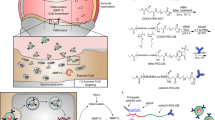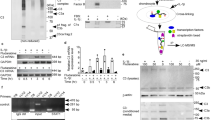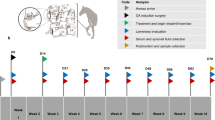Abstract
Reactive oxygen species (ROS) have been implicated in the pathogenesis of rheumatoid arthritis (RA), while antioxidant enzymes, such as extracellular superoxide dismutase (EC-SOD) and catalase, block radical-induced events. The present study tested if the ex vivo transfer of EC-SOD and catalase genes alone or in combination in the knee joint of rats with monoarticular antigen-induced arthritis (AIA) was anti-inflammatory, and examined the potential mechanisms involved. Synoviocytes isolated from female Wistar rats were immortalized with a retroviral vector SUV19.5. These cells were permanently transfected with an EC-SOD expression plasmid (pEC-SODZeo) or a catalase expression plasmid (pCatalaseZeo) to create cells overexpressing EC-SOD or catalase, as measured by RT-PCR and Western blots. The cells were engrafted in knee joints of animals at the time of the induction of AIA. Three gene transfer groups, an EC-SOD group, a catalase group and a combined therapy group (EC-SOD and catalase) were included in these experiments. Animals in the control group were engrafted with synoviocytes transfected with the plasmid pZeoSV2 without an insert. Clinical and histological assessments were performed, as well as tissue measurements of SOD, catalase and gelatinase activities. Ex vivo gene transfer of EC-SOD and catalase into rat knee joints produced about a six- to seven-fold increase in EC-SOD activity and a two- to three-fold increase in catalase activity compared with the control animals. Rats treated with cells overexpressing EC-SOD, catalase or a combination of EC-SOD and catalase showed significant suppression of knee joint swelling, decreased infiltration of inflammatory cells within the synovial membrane and reduced gelatinase activity in knee joints, compared with animals receiving cells transfected with the plasmid alone. No statistically significant difference was found between the groups treated with cells overexpressing EC-SOD, catalase or a combination of both. Gene therapy involving the local intra-articular overexpression of two antioxidant enzymes, EC-SOD and catalase, was anti-inflammatory in AIA. One mechanism appears to be the suppression of gelatinase activities by both EC-SOD and catalase.
This is a preview of subscription content, access via your institution
Access options
Subscribe to this journal
Receive 12 print issues and online access
$259.00 per year
only $21.58 per issue
Buy this article
- Purchase on Springer Link
- Instant access to full article PDF
Prices may be subject to local taxes which are calculated during checkout





Similar content being viewed by others
References
Winyard PG, Blake DR . Antioxidants, redox-regulated transcription factors, and inflammation. Adv Pharmacol 1997; 38: 403–421.
Li J, Oberley LW, Fan M, Colburn NH . Inhibition of AP-1 and NF-κB by manganese-containing superoxide dismutase in human breast cancer cells. FASEB J 1998; 12: 1713–1723.
Lee DM, Weinblatt ME . Rheumatoid arthritis. Lancet 2001; 358: 903–911.
Goldbach-Mansky R et al. Active synovial matrix metalloproteinase-2 is associated with radiographic erosions in patients with early synovitis. Arthritis Res 2000; 2: 145–153.
Gutteridge JM, Halliwell B . Free radicals and antioxidants in the year 2000. A historical look to the future. Ann NY Acad Sci 2000; 899: 136–147.
Marklund SL . Extracellular superoxide dismutase and other superoxide dismutase isoenzymes in tissues from nine mammalian species. Biochem J 1984; 222: 649–655.
Karlsson K, Sandstrom J, Edlund A, Marklund SL . Turnover of extracellular-superoxide dismutase in tissues. Lab Invest 1994; 70: 705–710.
Karlsson K, Marklund SL . Binding of human extracellular-superoxide dismutase C to cultured cell lines and to blood cells. Lab Invest 1989; 60: 659–666.
Carlsson LM, Marklund SL, Edlund T . The rat extracellular superoxide dismutase dimer is converted to a tetramer by the exchange of a single amino acid. Proc Natl Acad Sci USA 1996; 93: 5219–5222.
Karlsson LM, Marklund SL . Extracellular superoxide dismutase in the vascular system of mammals. Biochem J 1988; 255: 223–228.
Goebel KM, Storck U . Effect of intra-articular orgotein versus a corticosteroid on rheumatoid arthritis of the knees. Am J Med 1983; 74: 124–128.
Flohe L . Superoxide dismutase for therapeutic use: clinical experience, dead ends and hopes. Mol Cell Biochem 1988; 84: 123–131.
Schalkwijk J et al. Cationization of catalase, peroxidase, and superoxide dismutase. Effect of improved intraarticular retention on experimental arthritis in mice. J Clin Invest 1985; 76: 198–205.
Marklund SL, Bjelle A, Elmqvist LG . Superoxide dismutase isoenzymes of the synovial fluid in rheumatoid arthritis and in reactive arthritides. Ann Rheum Dis 1986; 45: 847–851.
Mattey DL et al. Alpha, mu and pi class glutathione S-transferases in human synovium and cultured synovial fibroblasts: effects of interleukin-1 alpha, hydrogen peroxide and inhibition of eicosanoid synthesis. Free Rad Res Commun 1993; 19: 159–171.
Agar NS, Sadrzadeh SM, Hallaway PE, Eaton JW . Erythrocyte catalase. A somatic oxidant defense? J Clin Invest 1986; 77: 319–321.
Winterbourn CC, Stern A . Human red cells scavenge extracellular hydrogen peroxide and inhibit formation of hypochlorous acid and hydroxyl radical. J Clin Invest 1987; 80: 1486–1491.
Almazan G, McKay R . An oligodendrocyte precursor cell line from rat optic nerve. Brain Res 1992; 579: 234–245.
Croxford JL, Feldmann M, Chernajovsky Y, Baker D . Different therapeutic outcomes in experimental allergic encephalomyelitis dependant upon the mode of delivery of IL-10: a comparison of the effects of protein, adenoviral or retroviral IL-10 delivery into the central nervous system. J Immunol. 2001; 166: 4124–4130.
Triantaphyllopoulos KA, Williams RO, Tailor H, Chernajovsky Y . Amelioration of collagen-induced arthritis and suppression of interferon-gamma, interleukin-12, and tumor necrosis factor alpha production by interferon-beta gene therapy. Arthritis Rheum 1999; 42: 90–99.
Dowling EJ et al. Assessment of a human recombinant manganese superoxide dismutase in models of inflammation. Free Rad Res Commun 1993; 18: 291–298.
Przedborski S et al. Superoxide dismutase, catalase, and glutathione peroxidase activities in copper/zinc-superoxide dismutase transgenic mice. J Neurochem 1992; 58: 1760–1767.
Gutteridge JMC . Superoxide-dependent formation of hydroxyl radicals from ferric-complexes and hydrogen peroxide: an evaluation of fourteen iron chelators. Free Rad Res Commun 1990; 9: 119–125.
Eberhardt W et al. Amplification of IL-1 beta-induced matrix metalloproteinase-9 expression by superoxide in rat glomerular mesangial cells is mediated by increased activities of NF-kappa B and activating protein-1 and involves activation of the mitogen-activated protein kinase pathways. J Immunol 2000; 165: 5788–5797.
Liochev SI, Fridovich I . Copper- and zinc-containing superoxide dismutase can act as a superoxide reductase and a superoxide oxidase. J Biol Chem 2000; 275: 38 482–38 485.
Gossen M et al. Transcriptional activation by tetracyclines in mammalian cells. Science 1995; 268: 1766–1769.
Iyama S et al. Treatment of murine collagen-induced arthritis by ex vivo extracellular superoxide dismutase gene transfer. Arthritis Rheum 2001; 44: 2160–2167.
Hjalmarsson K, Marklund SL, Engstrom A, Edlund T . Isolation and sequence of complementary DNA encoding human extracellular superoxide dismutase. Proc Natl Acad Sci USA 1987; 84: 6340–6344.
Winyard PG, Lunec J, Brailsford S, Blake DR . Action of free radical generating systems upon the biological and immunological properties of caeruloplasmin. Int J Biochem 1984; 16: 1273–1278.
Aebi H . Catalase in vitro. Methods Enzymol 1984; 105: 121–126.
Makarov SS et al. Suppression of experimental arthritis by gene transfer of interleukin 1 receptor antagonist cDNA. Proc Natl Acad Sci USA 1996; 93: 402–406.
Cruwys SC et al. The role of bradykinin B1 receptors in the maintenance of intra-articular plasma extravasation in chronic antigen-induced arthritis. Br J Pharmacol 1994; 113: 904–914.
Kleiner DE, Steller-Stevenson WG . Quantitative zymography: detection of picogram quantities of gelatinases. Anal Biochem 1994; 218: 325–329.
Marok R et al. Activation of the transcription factor nuclear factor-κB in human inflamed synovial tissue. Arthritis Rheum 1996; 39: 583–391.
Acknowledgements
We express our appreciation to Professor BL Kidd, Dr D Gould and Dr MC O'Shaughnessy for advice and assistance with the histological analysis of tissue samples.
Author information
Authors and Affiliations
Additional information
This work was supported by the Arthritis Research Campaign, UK and the Wellcome Trust
Rights and permissions
About this article
Cite this article
Dai, L., Claxson, A., Marklund, S. et al. Amelioration of antigen-induced arthritis in rats by transfer of extracellular superoxide dismutase and catalase genes. Gene Ther 10, 550–558 (2003). https://doi.org/10.1038/sj.gt.3301916
Received:
Accepted:
Published:
Issue Date:
DOI: https://doi.org/10.1038/sj.gt.3301916
Keywords
This article is cited by
-
Innate inflammation and resolution in acute gout
Immunology & Cell Biology (2010)
-
Effects of exposure to hyperbaric oxygen on oxidative stress in rats with type II collagen-induced arthritis
Clinical and Experimental Medicine (2010)
-
Molekulare Werkzeuge zur Wiederherstellung von arthrotischem Knorpel
Der Orthopäde (2009)
-
Gene therapy for autoimmune diseases: quo vadis?
Nature Reviews Immunology (2004)



